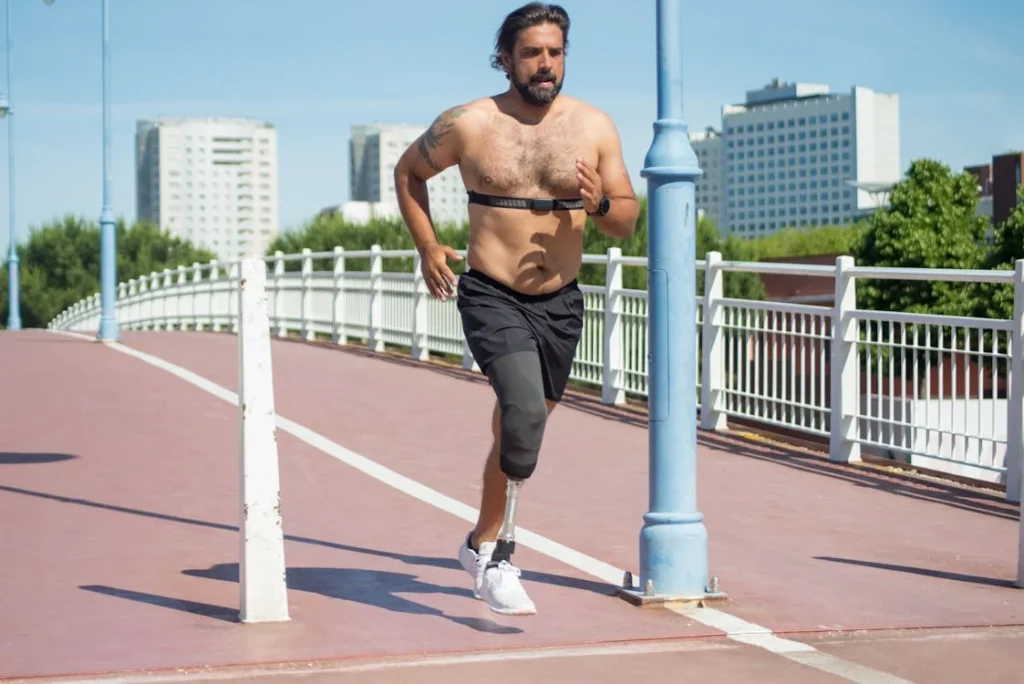Living with a prosthetic limb is a journey that goes beyond just wearing an artificial hand or leg. It’s about learning how your body and the prosthetic can work together as a team. One of the biggest challenges people face after amputation is residual limb pain — the pain that comes from the part of your limb that remains after surgery. This pain can show up as aching, burning, or sharp stabs, and it can make everyday tasks difficult. For some, it even becomes a constant part of life.
But it doesn’t have to stay that way.
A major reason behind this pain often comes down to something many people don’t hear enough about: load transfer. That’s a simple term for how your weight and pressure are spread through your limb and your prosthetic. When the load isn’t transferred well, too much pressure builds up in the wrong places. And that leads to pain.
The good news? You can do a lot to improve this. With the right fit, proper alignment, good socket design, and smart choices about how you move and wear your prosthesis, you can reduce — and in many cases, almost eliminate — residual limb pain caused by poor load transfer.
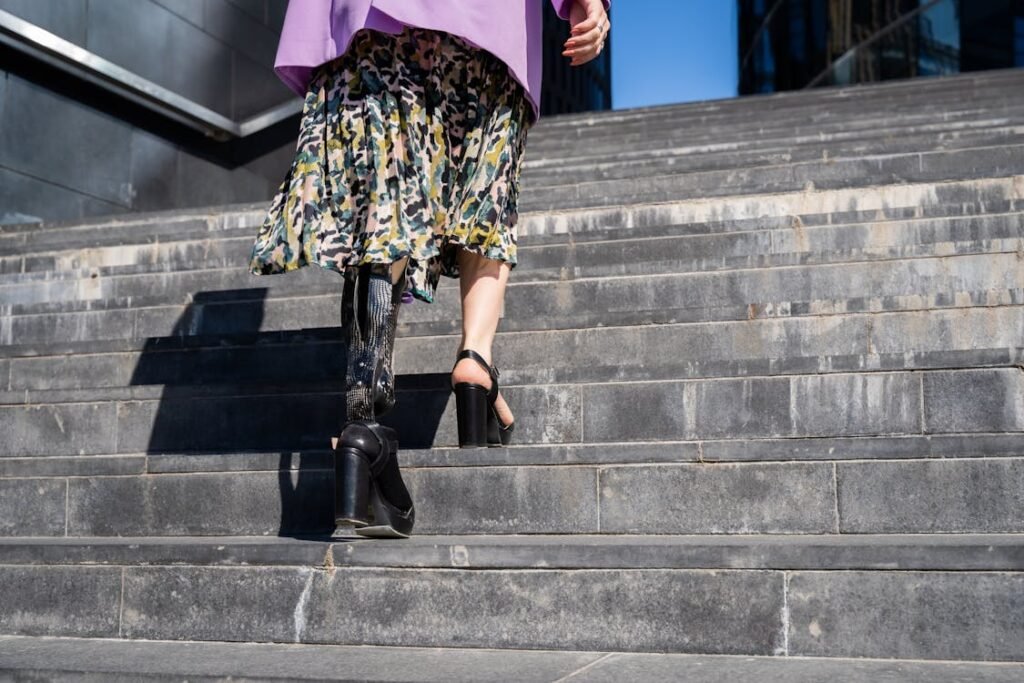
Understanding the Role of Load Transfer
What Is Load Transfer?
Load transfer is how the force of your body weight moves through your residual limb into your prosthesis and then down to the ground. When you stand, walk, or even shift your weight while sitting, your body is constantly handling pressure.
For people with natural limbs, muscles, tendons, and bones work together to handle this pressure smoothly. But with a prosthesis, things change. The way your limb connects to the artificial one now plays a big role.
The main goal is to make this connection as smooth and natural as possible so that your residual limb isn’t forced to take pressure in ways it wasn’t meant to.
If that pressure isn’t managed correctly, tissues can get damaged, nerves can be irritated, and pain starts to build.
Why Poor Load Transfer Leads to Pain
Residual limb pain often starts small. Maybe you notice a sore spot after walking for a while, or the skin gets red under the socket. Over time, these small issues grow.
Skin breaks down, muscles tighten, and inflammation can spread. If the load is being pushed into one part of your limb too much — especially over bony areas — it can cause sharp or throbbing pain.
This happens when:
- The socket doesn’t fit your limb well
- The alignment of the prosthesis is off
- Your gait (the way you walk) is uneven
- The cushioning inside the socket is worn out or not supportive
- Your limb shape changes over time, but your socket doesn’t
When the load isn’t shared across the limb evenly, the soft tissues, bones, and nerves start to protest. That’s your body telling you something’s not right.
Why It’s Not Just About the Socket
It’s easy to think that socket fit is the only thing that matters. But load transfer is bigger than that. It’s about how the whole prosthetic system works with your body. This includes:
- The shape and design of your socket
- The kind of liner or cushioning you use
- The angle and position of the prosthesis
- The way you move, walk, and carry yourself
- How strong your muscles are
- Even the shoes you wear with your prosthetic leg
All of these things work together. If one part isn’t right, it puts more pressure on the others. That’s when pain shows up.
Getting the Basics Right
The first step in fixing poor load transfer is understanding how your prosthesis should feel. It should feel snug but not tight, secure but not pinching, and stable but not stiff.
You should be able to walk without feeling like your limb is sliding around inside the socket. If you’re bracing or limping, that’s a sign something is off.
Pain should never be something you just live with. Discomfort in the early days is normal as your body adjusts. But persistent pain — especially sharp, burning, or deep aching pain — is a red flag.
Your Body Always Gives Clues
Watch for signs like:
- Redness that doesn’t go away
- Skin that breaks or blisters
- Soreness after just a little walking
- Needing to take the prosthetic off often for relief
- Limping or changing your posture without noticing
These are all signs that load is being placed in the wrong way. The goal is to fix that before the pain becomes constant.
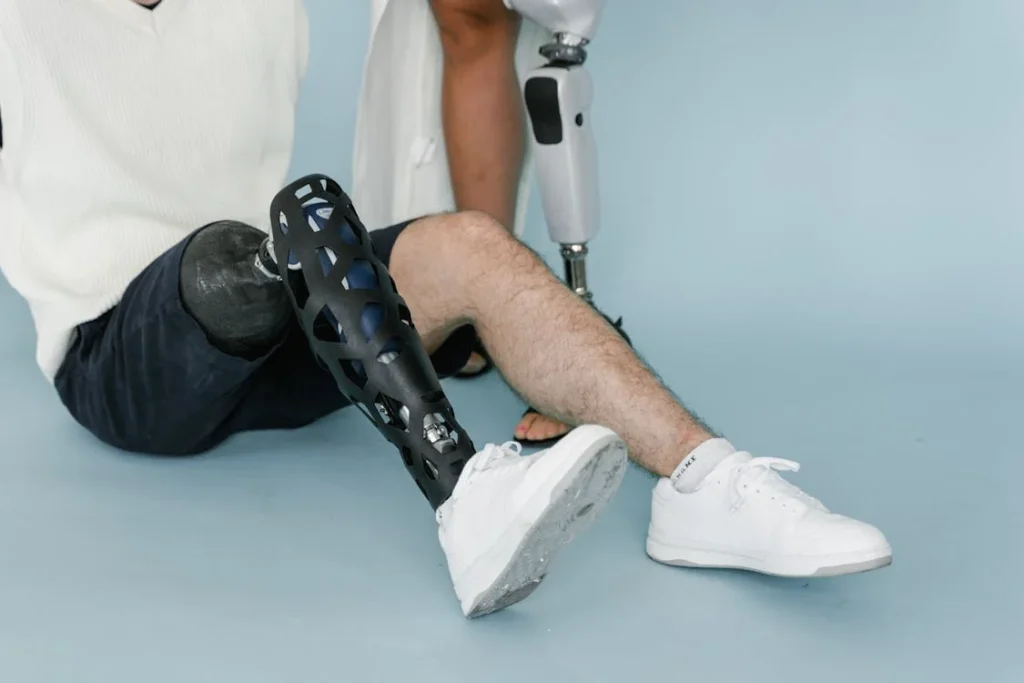
Common Mistakes That Disrupt Load Transfer
The Danger of a Poorly Fitting Socket
One of the most common and often overlooked causes of residual limb pain is a socket that simply doesn’t fit right. A socket that is too loose can cause your limb to move inside it.
That movement creates friction, pressure points, and uneven weight distribution. On the other hand, a socket that is too tight may compress soft tissue or nerves, cutting off circulation or causing inflammation.
When the fit is off, the load does not spread evenly across the surface of the residual limb. Instead, it concentrates in certain areas, especially around bones, and this leads to discomfort and tissue damage over time.
The shape of your residual limb can change over weeks or months. It may shrink due to muscle loss or change because of weight gain, fluid retention, or muscle growth.
When that happens and the socket is not adjusted or replaced, the load transfer gets worse each day. Many people try to adjust for this by adding socks or padding, but while that might offer temporary relief, it does not fix the actual issue. The socket needs to match the limb, not the other way around.
Misalignment and Its Subtle Impact
Even when your socket fits well, the way your prosthesis is aligned matters just as much. Misalignment means that your prosthesis might be tilted too far in one direction, or the angle may be slightly off.
This shifts the load in ways that your limb cannot handle well. The tricky part is that small misalignments are hard to notice at first. You might not even feel them right away.
But after days or weeks, the strain builds. Muscles get sore from working too hard to balance you. Joints take on more pressure than they should. The result is discomfort that becomes more and more consistent.
Your walking pattern may also start to change in subtle ways. You may begin favoring one side or walking with a slight limp.
This makes the load transfer even more uneven, and it adds stress not just to your residual limb but also to your back, hips, and other leg.
The whole body tries to adapt, and in doing so, it can create more pain in other areas, making it harder to pinpoint the root cause.
Neglecting Muscle Strength and Posture
People often think of prosthetics as mechanical devices, but your body plays just as much of a role in making them work well. Strong muscles around the hip and core help guide proper load transfer.
If those muscles are weak, especially after surgery or prolonged rest, the prosthetic limb does not have the support it needs.
When that support is missing, pressure gets forced into the residual limb unevenly. This causes the soft tissues to carry more load than they should, leading to soreness and fatigue.
Posture also plays a key role. Slouching, leaning to one side, or twisting your body without realizing it changes the way load moves through your body.
These habits may come from trying to avoid pain or discomfort, but they often make things worse over time.
When posture isn’t aligned, the prosthetic socket ends up bearing the load at the wrong angle, which puts even more strain on the limb.
Overuse Without Rest and Recovery
In the early days of using a prosthesis, it’s tempting to push through pain to prove to yourself that you can handle it. Many people want to regain their independence quickly, and that’s admirable.
But doing too much, too soon, without rest can backfire. Your residual limb needs time to adjust to the forces being placed on it.
The skin, tissues, and muscles all have to adapt slowly. When you skip that step and try to walk or stand for long periods right away, pain becomes almost inevitable.
Your limb also swells more easily in the beginning. If the socket fits in the morning, it might feel tight by the afternoon, simply due to swelling from overuse.
That tightness changes how the load is carried, again creating uneven pressure. Rest isn’t a sign of weakness. It’s a necessary part of learning how to use your prosthetic limb in a safe and lasting way.
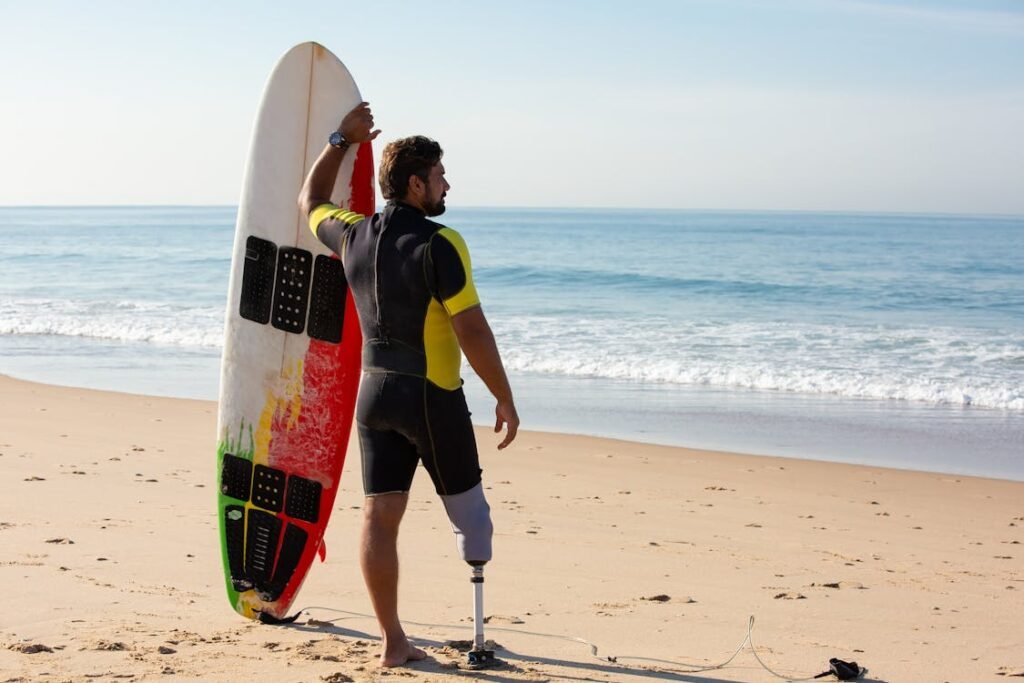
Steps to Improve Load Transfer and Reduce Pain
Start With a Thorough Evaluation
The first and most important step to reducing residual limb pain is getting a proper evaluation. This means working with a prosthetist who takes the time to understand your unique limb shape, muscle tone, and walking style.
A good evaluation goes beyond just measuring your limb. It looks at how you move, where you feel pressure, and how your skin reacts to wearing the prosthesis. Without this detailed look, even the most advanced prosthetic device might not help if it doesn’t match your body’s real needs.
This is where honest conversations matter. You need to share where it hurts, how often it happens, and what movements make it worse. Your feedback helps the prosthetist make the right adjustments.
A rushed fitting or a one-size-fits-all approach almost always leads to long-term problems. Every limb is different, and that’s why personalized care is so important.
Focus on Socket Comfort and Fit
Once your limb is evaluated properly, the socket design becomes the next focus. A well-fitting socket should distribute pressure across the entire surface of your limb, not just one or two areas.
It should feel snug without digging into your skin or pinching soft tissues. The fit should stay consistent throughout the day. If it feels perfect in the morning but causes pain by afternoon, that means something in the design or alignment is off.
Small changes can make a big difference. Sometimes adjusting the angle by just a few degrees or changing the type of liner can relieve pressure points that have caused weeks of discomfort.
Your socket should also allow your skin to breathe and stay dry. Sweat buildup leads to slippage, which changes the way load is transferred. Moist skin is also more likely to break down under pressure. Materials that reduce heat and wick away moisture help avoid this.
Over time, as your limb shape changes, you’ll likely need the socket refitted or replaced. This isn’t a failure — it’s a natural part of the process. Ignoring these changes leads to more pain. Checking in with your prosthetist every few months can help catch problems early before they become harder to manage.
Improve Alignment for Better Balance
Alignment is another key part of good load transfer. The goal is to have your prosthetic limb line up with your natural movement, so your weight moves smoothly from your hips to the ground.
If alignment is off, even slightly, your body compensates by shifting weight in unnatural ways. That might not hurt on day one, but it almost always leads to pain down the road.
Getting your alignment right means working with a team that watches how you walk and stand. It’s not just about how things look on paper. It’s about how they work in real life.
A few degrees of tilt, or a small adjustment in foot placement, can change everything. These tweaks can help spread pressure more evenly across the socket and reduce stress on sensitive areas of your limb.
Sometimes the fix is simple. Adjusting the height of your prosthesis or the angle of your foot can bring immediate relief. In other cases, it might take a few trials to find the best setup.
Either way, staying patient and working closely with your prosthetist is worth it. Proper alignment helps you walk more naturally, reduces pain, and protects your joints from wear and tear.
Strengthen Muscles for Better Support
Your prosthesis isn’t working alone — it needs help from your muscles. When your core, hips, and remaining limb muscles are strong, they guide movement more smoothly.
This allows for better control and helps spread the load more evenly through your body. Weak muscles, on the other hand, lead to wobbling, poor balance, and uneven steps. This throws off the load transfer and makes your residual limb work harder than it should.
Targeted exercises that focus on balance, core strength, and posture can help a lot. You don’t need fancy gym equipment or long workout sessions. Simple routines done consistently are often the most effective.
Stretching is just as important as strengthening. Tight muscles pull your body out of alignment, which again leads to uneven load and pain.
Working with a physiotherapist who understands prosthetics is ideal. They can design a plan that matches your needs and abilities. If in-person sessions aren’t possible, many guided home programs can still offer solid results.
What matters most is staying consistent and giving your muscles the time and attention they need to support you.

Fine-Tuning Movement and Daily Habits
Walk Smarter, Not Harder
Walking is one of the most common activities we all do, and for someone using a prosthesis, it becomes the foundation of how load transfers through the body every single day.
But walking isn’t just about moving one foot in front of the other. The way you walk—your stride, step length, posture, and how your body weight shifts—can all impact the pressure placed on your residual limb.
If you’re leaning too far to one side, or if your stride is uneven, your prosthesis may be absorbing the load in a way that stresses certain parts of your limb. This leads to discomfort over time, especially if you continue to walk that way out of habit.
Many people aren’t even aware they’re doing it. They simply adjust their walk to avoid discomfort and slowly develop new movement patterns. Unfortunately, those patterns often place pressure where it doesn’t belong.
A gait assessment, either by a prosthetist or a physical therapist, can help you identify these small habits and make simple adjustments. Sometimes it’s a matter of pausing and resetting your posture.
Other times, you may need to slow down and take shorter steps to help your body adapt more smoothly. With time and practice, these small changes can lead to major improvements in how load is spread through the prosthesis.
Listen to Your Skin and Body
Your skin is one of the best early warning systems you have. It reacts quickly to pressure, friction, moisture, and movement. If your skin becomes red, sore, or broken, it’s telling you that something in your prosthesis setup is off.
This isn’t something to ignore or power through. The more you ignore these signs, the more likely it is that pain will become a bigger and more stubborn problem.
Check your limb every day, especially in the areas that usually bear the most weight. Look for redness that doesn’t fade after removing the prosthesis.
Notice if you feel a burning or pinching sensation when you walk or stand. Be mindful of any areas that feel numb or tingly, as this can also indicate that nerves are being compressed by uneven load transfer.
Pain doesn’t always show up immediately. It often builds over time, starting with discomfort and slowly becoming a barrier to daily life. Addressing small issues early is one of the most effective ways to avoid long-term pain.
If something feels even slightly off, bring it up with your prosthetist. Adjustments don’t have to be drastic to make a big difference.
Rest and Activity Should Work Together
It’s easy to think that staying active all day is the best way to adapt to a prosthesis. But activity without the right amount of rest can do more harm than good.
Your residual limb needs breaks to recover, especially if you’re on your feet for long periods or doing new activities. The tissues inside your limb can swell, become irritated, or simply tire out. If you keep pushing without giving your body time to heal, pain becomes more likely.
Finding the right rhythm between movement and rest is personal. Some people need more frequent short breaks, while others do well with longer periods of activity followed by longer rest.
There’s no one-size-fits-all answer. The key is to notice how your limb feels throughout the day and respond to those signals. If you feel pressure building or discomfort increasing, stop and take the weight off your limb.
Wearing schedules can help, especially in the early stages. Start with short sessions and slowly increase the time you wear your prosthesis each day. This allows your limb to toughen up without overwhelming it.
Over time, your skin and tissues adapt, and you’ll find you can stay active longer without discomfort. But even then, rest should remain a regular part of your routine.
Keep the Environment in Mind
Many people don’t realize how much things like temperature, surface, and even footwear can affect load transfer. Walking on soft ground, slippery surfaces, or uneven terrain changes the way your body reacts.
Your muscles engage differently, your posture shifts, and the prosthesis handles pressure in new ways. On hot days, sweat builds up inside the socket faster, which increases friction and affects how your limb fits.
In cold weather, your skin might become dry or more sensitive, and muscles may stiffen. These changes affect how weight is carried and how comfortable your prosthesis feels.
Paying attention to your environment helps you plan better. On hot days, you might need to clean and dry the inside of your socket more often. On rough ground, you may want to slow down and focus more on balance.
Even the shoes you wear matter. A thick sole, high heel, or uneven wear on the bottom of a shoe can tilt your prosthesis slightly and disrupt the alignment.
That small change might not be obvious at first, but it alters how load transfers through your limb. Choosing footwear that offers stable, even support helps maintain balance and reduce strain on your body.
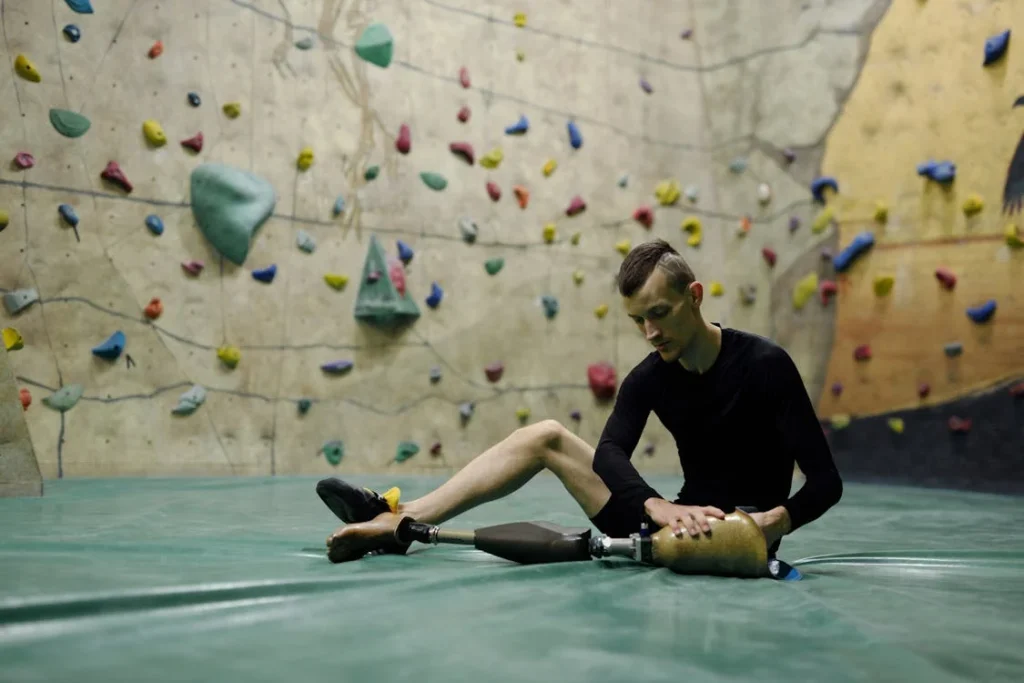
The Importance of Long-Term Maintenance and Adaptation
Your Prosthesis Is Not a Set-It-and-Forget-It Device
One of the most common misunderstandings about prosthetics is that once you’ve got a good fit, you’re set for life. In reality, your body is always changing, and that means your prosthesis needs to change with it.
Your residual limb might lose or gain volume due to changes in activity level, diet, or natural healing. What fits comfortably now may start to feel tight or loose in just a few months.
If that happens and you don’t adjust the socket or alignment, the load begins to shift unevenly again, which leads to pain.
Being proactive is key. That means setting regular check-ins with your prosthetist even when things feel okay. These appointments aren’t just about fixing problems.
They’re about preventing them. A small adjustment today can save you from a much bigger issue in the future.
Think of it the same way you’d think about keeping a car running smoothly—routine maintenance avoids breakdowns. Your prosthesis works best when it’s tuned to your current needs, not how you were six months ago.
Even small things, like replacing a worn-out liner or switching to a better cushioning material, can improve how pressure is spread across your limb.
When materials get thin or start to compress unevenly, they no longer protect you from pressure points. This increases your risk for skin problems and nerve pain. Keeping your components in good condition supports better load transfer and, in turn, reduces discomfort.
Stay Ahead of Changes in Your Limb
You might not notice it right away, but your residual limb can change in subtle ways over time. These changes may come from natural tissue shifts, muscle use, or even how you move day to day.
If your limb starts to shrink slightly, your socket might feel a bit looser. That looseness leads to more movement inside the socket, which causes rubbing and skin irritation. Over time, this increases the chance of blisters, sores, and inflammation.
On the other hand, if your limb swells from overuse or fluid retention, the socket might begin to feel too tight. That extra pressure can squeeze soft tissue and make nerves more sensitive.
You might also notice pressure points where none existed before. When this happens, adding or removing prosthetic socks might help in the short term, but it’s not a long-term fix. You’ll need to talk to your prosthetist to consider re-casting or refitting the socket.
These changes don’t mean something is wrong with your body—they’re normal. But ignoring them leads to uneven load distribution and pain. It’s important to pay attention to how your socket feels every day.
A good rule of thumb is this: if something feels different for more than a few days, it’s worth looking into. The earlier you catch the change, the easier it is to adapt your prosthesis to fit well again.
Don’t Ignore New Discomfort
Pain can creep in slowly. Maybe you feel a small ache after a longer walk, or there’s a pinch you didn’t notice before. It’s tempting to brush it off and assume it will go away.
But pain is your body’s way of signaling that something isn’t right. If you ignore it, the issue often gets worse.
Soft tissue may become inflamed, or your gait may change as you unconsciously shift weight to avoid the sore area. That shift leads to new pressure points and starts a cycle that’s harder to break.
Even if the pain is minor, it’s worth asking why it’s there. Has your limb changed shape? Are you wearing different shoes? Has your activity level increased? Are the socket or liner materials wearing down?
These are all questions to consider. Tracking small changes and discussing them with your prosthetist gives you a better chance of stopping pain before it becomes chronic.
Pain also affects how confident you feel when moving. If every step reminds you of a sore spot, you may hold back, avoid certain movements, or limit your activity.
That can weaken muscles and further disrupt load transfer. Staying ahead of pain, even mild pain, helps you keep moving confidently and safely.
Build a Strong Support System
Living with a prosthesis doesn’t mean you have to figure everything out alone. Having a team around you—a prosthetist, physiotherapist, and even other prosthetic users—can make a big difference.
These people offer not just practical advice but also emotional support when things get tough. Talking about your experiences helps you learn faster and avoid common mistakes.
Support also keeps you motivated. There will be days when the prosthesis doesn’t feel right, when you’re tired, or when progress feels slow.
On those days, it helps to have someone remind you how far you’ve come and what steps to take next. Sharing what works for you, and hearing what’s worked for others, can lead to small changes that make a big difference in how your prosthesis fits and feels.
Education is another part of this. The more you understand about your prosthesis, the better you can care for it and your limb. Learn how to spot signs of wear and how to clean and check your components.
Understand what different types of discomfort mean and what adjustments might help. When you know what to look for, you can respond quickly and effectively.
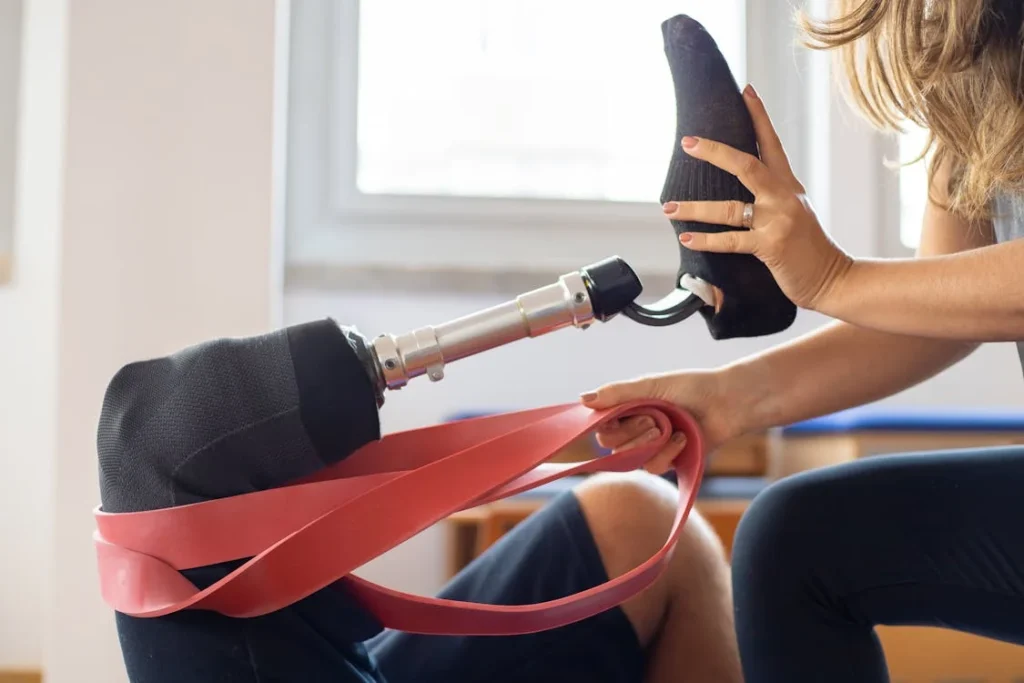
The Role of Rehabilitation in Optimizing Load Transfer
Why Rehab Isn’t Just for Recovery
Many people think rehabilitation is only something you do right after surgery or in the first few months of getting a prosthesis. But real progress happens when rehab is seen as an ongoing part of your life with a prosthetic limb.
It’s not just about healing from the operation. It’s about teaching your body how to move well with a new setup, building strength in the right places, and constantly improving how weight moves through your limb.
Rehabilitation plays a big role in how your body learns to manage load. If you go without it or stop too early, your body may develop movement patterns that feel easier in the short term but lead to uneven pressure and pain in the long run.
You may start to lean, favor one side, or lock your knee while walking—all small habits that slowly pull the load away from where it’s meant to go. These habits put strain on your residual limb and can also affect your back, hips, and remaining leg.
Continued rehab teaches you how to avoid those habits. It helps you stay in tune with how your body feels and what movement patterns are safest. More importantly, it helps you keep adjusting as your limb and body change over time.
Your gait might be very different one year after amputation than it was in the first few months. Rehab gives you tools to grow with those changes instead of falling behind.
Adapting to Your Prosthesis Through Movement
Your prosthesis doesn’t work in isolation—it’s part of your body now, and like any new part, your body needs time to get used to it. Movements that were once automatic now take some re-learning.
Walking, standing, sitting, and even balancing on one foot all require you to develop a new sense of where your body is in space. This sense is called proprioception, and it changes after limb loss.
Rehabilitation exercises help retrain your brain and muscles to understand this new sense of balance and control. With each session, your movements become smoother and more natural.
And as they do, the pressure on your residual limb becomes more balanced. Instead of one part of the socket taking all the force, the load is shared across a larger area, which is exactly what you want for comfort and safety.
You’ll also notice that movements become more fluid and less tiring. Early on, people often report that walking with a prosthesis feels like hard work. That’s because their body is using small muscles to try to stay stable.
Rehab helps you switch to using stronger, larger muscles in your legs, hips, and core. These muscles are better suited to carry weight, and they do a better job of spreading the load so your residual limb isn’t overworked.
Gamified and Home-Based Rehab: Making Progress Fun and Sustainable
Rehabilitation doesn’t have to feel like a chore. In fact, when it feels rewarding and engaging, you’re more likely to stick with it. That’s why newer approaches to rehab, like gamified exercises and home-based programs, are gaining attention.
These methods turn repetitive tasks into interactive games that track your progress and give real-time feedback. Instead of just lifting your leg or shifting your weight, you might find yourself reaching a goal, winning a challenge, or leveling up—right in your living room.
This kind of engagement isn’t just fun—it’s effective. It encourages regular movement and reinforces proper techniques.
With home-based options, you don’t need to travel for every session, which makes rehab more accessible and easier to stick with. These programs are especially helpful for people who live far from rehab centers or have limited mobility.
Over time, these exercises become part of your daily life. You may spend just 15 or 20 minutes a day focusing on controlled movement, posture, and balance.
But those minutes build the foundation for better walking, less pain, and stronger muscles. The more consistent you are, the more likely you are to reduce residual limb pain by improving how your body transfers load through your prosthesis.
Confidence Comes With Practice
As your body grows stronger and your movements become more controlled, you’ll start to trust your prosthesis more. That trust is key. When you feel unsure about how your limb will respond, you move cautiously.
That cautious movement often leads to stiffness, hesitation, and missteps—each of which shifts load in an uneven way.
Confidence allows you to move smoothly and naturally. You stop overthinking each step and begin to let your body take over.
And as your movement becomes more natural, load transfer improves. Instead of stopping to adjust every few steps or worrying about pressure spots, you’ll find yourself focusing more on where you’re going than how you’re getting there.
This confidence doesn’t come all at once. It builds slowly, through repetition, support, and small wins. One day you realize you walked across the room without pain.
Another day you go for a longer walk outside and enjoy the freedom of movement. These moments are signs that your body is learning to work with your prosthesis—not against it. And that’s the real goal of proper load transfer: to make every step feel like your own.
Conclusion
Reducing residual limb pain isn’t about just enduring it—it’s about understanding how your body and prosthesis work together. At the heart of that connection is proper load transfer. When your weight is spread evenly and your prosthesis fits well, discomfort can be greatly reduced or even prevented. This isn’t achieved through one single fix, but through a combination of the right socket fit, smart alignment, regular adjustments, muscle strength, and ongoing rehabilitation.
Listening to your body, staying consistent with movement, and making time for routine check-ups are key to long-term comfort. Progress takes patience, but each step brings you closer to ease, balance, and confidence in daily life. You deserve to move freely, without pain holding you back.



